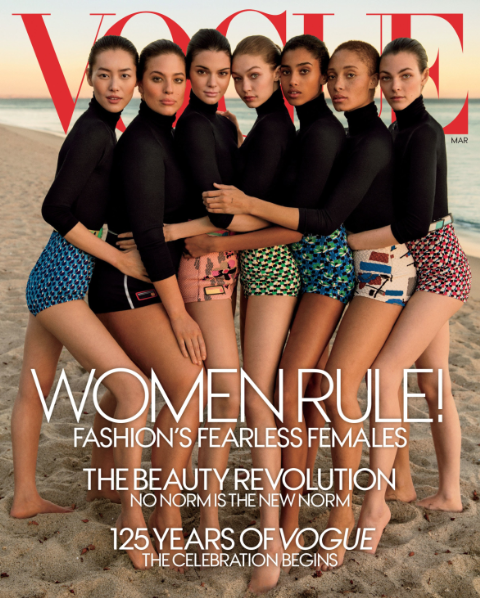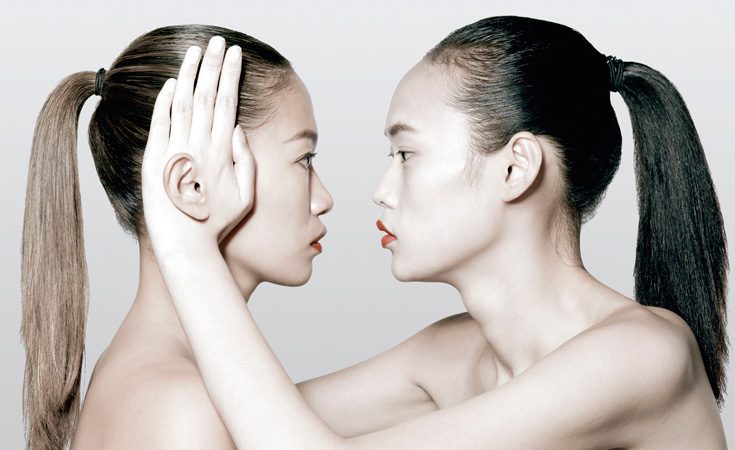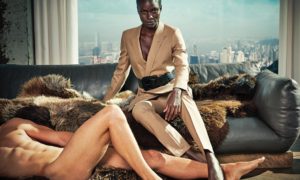
This months Vogue cover with six identical diverse models
American model Karlie Kloss graces the brand new cover of Vogue America’s Diversity issue. “A diversity issue, what a great concept!” you might think. You might not care too much about the fact that the six diverse models on Vogue’s cover look totally identical, because hey: it’s Vogue. But the drama unfolds when the diversity-issue opens and unleashes serious cultural appropriation on you. Many feminists are seriously pissed off at Vogue for attempting to whitewash an important part of Japanese Geisha culture.
In the photoshoot Kloss is dressed as a geisha, a traditional female entertainer. So what’s the deal? Vogue is just paying tribute to an important part of Japanese culture, right?
White actors in non-white roles
Well, no. What Vogue did is a practice known as ‘whitewashing’. Whitewashing refers to the casting process in the film industry where white actors are chosen to portray non-white characters. In 2015 outrage sparked as Emma Stone played a woman of Hawaiian and Asian descent in Aloha. Similar cases include Scarlett Johansson and Matt Damon: white actors cast in non-white roles.
Emma Stone, Scarlett Johansson, and Tilda Swinton turn to Karlie Kloss. "Your turn, girl."
Karlie on phone: "Hello, Vogue? Make me Asian." pic.twitter.com/zgUWIB022Q
— Ira Madison III (@ira) 14 februari 2017
Whitewashing is problematic because it harms the representation of People of Colour. Traditionally, very few traditional PoC roles are available in Hollywood (and also in the fashion industry, for that matter). Taking up that space by casting white people in those roles is ignorant, considering Europe’s history with colonialization. Whitewashing in culture simply means taking over non-white space, all over again.
Secondly, there’s the more general problem of sexualizing Eastern cultures. A common misconception in the West is that Geishas are akin to prostitutes, which is definitely not the case. Instead they are women who are highly skilled at different Japanese arts, like classical music and dancing.
Sexualizing Eastern cultures
Sexualizing this part of the Japanese culture fits into the frame of Orientalism, a term that originated in the academic world. The theory of Orientalism studies cultural representations, and more specifically how Eastern culture is perceived in the West. This is often as mysterious, exotic and indeed sexual, like some of the photos from Vogue‘s new issue.
Then there’s also the issue of cultural appropriation, adapting elements of one, non-Western culture to fit dominant white culture. In the case of Vogue, a Japanese tradition was taken out of its cultural context to be made to ‘fit into’ white culture, namely Western fashion. This is all the more painful, considering the specific edition of this Vogue: the DIVERSITY issue. Whereas Kloss was given a six-page spread, the only two models of colour were given just one picture each.
Kloss has already apologised, stating that next time she’ll make sure to take part in a shoot that represents all women. But that doesn’t take away the fact that Vogue – and indeed Kloss – will make a lot of money from this particular issue. The one issue where diversity amongst women was supposed to be celebrated, turned into simply another embarrassingly whitewashed product.















